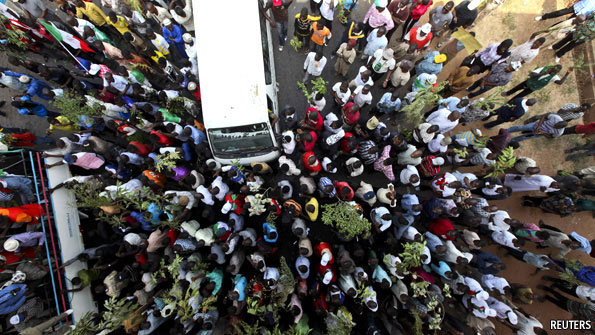According to the United Nations, Sub-Saharan Africa’s population (900 million currently) is expected to be more than five times larger than Europe’s in 2100. By then, Nigeria alone will have a population of 700 million people, 40% more than the combined populations of the European Union's 27 member states. If such a profound shift is difficult to take in, Hans Rosling has some appealing, easy-to-digest video guides to long-term global population increase. He explains it with high-technology here, with Ikea boxes here and with pebbles here.
Belatedly, the world is waking up to the huge strains a demographic explosion on this scale would create. A group of leading scientists from developed and developing nations are calling on Rio+20, the UN Conference on Sustainable Development, to take urgent action on population control. Next month in London, an international summit organized by the Gates Foundation and the UK Government will try to raise $4bn to secure access to family planning for 120 million women. These moves are encouraging - for too long, the divisive subject of overpopulation has been taboo. With Africa's population spiraling, concerted effort is needed to head off a Malthusian nightmare. Let’s examine four key drivers of Africa’s current population explosion.
1. Improved child mortality rates. As The Economist said recently, Parts of Africa are experiencing some of the biggest falls in child mortality ever seen, anywhere.
2. Family planning (lack of). The WHO says 22% of African married women are at risk of an unplanned pregnancy but are not using contraception – in Asia, the figure is 9%.
3. Female education (lack of). Not enough girls attend secondary school. UNICEF says that an extra year of schooling for girls reduces fertility rates by 5 to 10 per cent.
4. Behavioural economics. Particularly in rural communities, children are seen as cheap labour and as a kind of insurance policy.
For population growth to be sustainable, coordinated action is needed to amplify the first trend while rectifying the other three. There's still an enormous way to go on child mortality. A report from Save the Children says newborn deaths in sub-Saharan Africa are falling by a measly 1.5 percent per year, and that 75% of deaths could be prevented by the universal provision of cheap, effective interventions like Kangaroo Mother Care, which wraps babies and mothers together to provide warmth. If poor families are confident their babies will survive, they feel under less pressure to produce another quickly. Everywhere in the world, better child mortality rates = smaller families.
Regarding family planning and education for girls, these are two areas where policy-makers, aid agencies, NGOs and the private sector all have a part to play in achieving progress. If they work together, Babatunde Osotimehin, the former Nigerian Health Minister who runs the United Nations Population Fund, says that "rapid change" can be delivered on birthrates. In rural communities, joint public/private action is needed to help agricultural systems become more efficient. By creating stable markets, the most vulnerable can be lifted out of poverty.
Finally, as Africa urbanizes, the main emphasis must be on the need to create jobs in cities, as our recent Future Cities conference in Lagos discussed. When you lift city dwellers out of poverty and into the middle-class, they tend to make similar choices about family sizes: they have fewer kids.
Action is therefore needed on a number of fronts, and from a number of actors, if the 21st century population explosion is to be managed sustainably. It won't happen by itself; it's up to everyone to keep this issue high on the international agenda.
If you’re interested in population issues and would like to comment on this article, please do - your opinion will be most welcome.
Dougal




